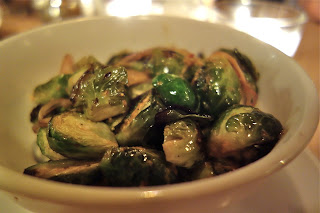Sometimes a restaurant is more enjoyable while you are there than maybe it is in retrospect. Such is the power of the brain, psychologically, so in that respect, Freud is befittingly named. They call it that because of Freud's theory that pleasure is most easily attained by oral gratification- i.e. stuffing your gob with delicious munchies. It's really a lovely little restaurant in which to do so, dark, polished wood finishings and big plate glass windows at the entrance offer a nice balance of light and dark. When the daylight ebbs, but still shines enough light in through the panes, it creates a magical
 effect. Marble tabletops and glossy white tiles reflect flickery candle light, giving a touch of refinement humbled by mossy plants
effect. Marble tabletops and glossy white tiles reflect flickery candle light, giving a touch of refinement humbled by mossy plantsand wobbly, elemental, and somewhat uncomfortable seating. Which for some reason isn't off-putting- it just seems unfussy and simple.
 Which is in large part the framework of the menu as well, Austrian, but lightened with a seasonal modernity. Many of the dishes aren't quite what they'd seem, however- perhaps this is an intentional psychological ploy, but it doesn't always lead the diner to a satisfactory conclusion. For example, crushed beets with whipped liptauer cheese is actually primarily just a cheesy spread tinged with a beet puree and a few more diced atop. The crackers are thick, buttery rusks, salty and perfect with the creamy dip. But if you wanted beets, you're basically getting crackers and cheese. Similar situation with the Roasted Root Vegetable Salad, comprised mostly of winter squash that was either roasted skin-on so all its roastiness was peeled away, or else, the gourd
Which is in large part the framework of the menu as well, Austrian, but lightened with a seasonal modernity. Many of the dishes aren't quite what they'd seem, however- perhaps this is an intentional psychological ploy, but it doesn't always lead the diner to a satisfactory conclusion. For example, crushed beets with whipped liptauer cheese is actually primarily just a cheesy spread tinged with a beet puree and a few more diced atop. The crackers are thick, buttery rusks, salty and perfect with the creamy dip. But if you wanted beets, you're basically getting crackers and cheese. Similar situation with the Roasted Root Vegetable Salad, comprised mostly of winter squash that was either roasted skin-on so all its roastiness was peeled away, or else, the gourdwas steamed, but it was that that was the prominent component of the salad, anyways, which isn't even a root. Not the turnips that were furled into cones as garnish, or the few carrots stretched beneath. Too bad, because those were the best part. The squash itself was pasty, and the peanut vinaigrette far too acerbic: it almost stung in its bite. Albacore tuna crudo, perhaps not particularly Austrian, was nudged in that direction with toasty pumpkin seeds and crispy wisps of sunchoke, the basil oil pooling beneath had such a touch of zesty heat. Crunchy crystals of salt heightened the oceanic freshness of the plush slabs of fish.
Scallops were a lovely choice as well, and at least their butternut squash was designated. The scallops were excellently browned, assertively enough to stand up to the meaty, lean morsels of
 dense blood sausage, just gently minerally but not metallic. By far the best part of the dish, however, were the buttery oak wood shittake mushrooms, halved and chewy. I don't know if it
dense blood sausage, just gently minerally but not metallic. By far the best part of the dish, however, were the buttery oak wood shittake mushrooms, halved and chewy. I don't know if it was this specific varietal that they've found to be such an exceptional fungus, or how it was cooked, but a whole dish of these as a side would've bumped up my star rating of the whole restaurant... if I were one to dole out stars. Speaking of stars, the best entree was luscious skirt steak with charred alliums and celeriac. The savory meat jus pooled beneath would've improved every dish we had,
 and justly benefited this tender cut as well. Plate-licking justified. There's a Hemlock Hen on the menu that was tempting, but turns out it's just a roasted chicken: not there's anything wrong with that, especially well done as it appeared, but I was looking for a little more danger.
and justly benefited this tender cut as well. Plate-licking justified. There's a Hemlock Hen on the menu that was tempting, but turns out it's just a roasted chicken: not there's anything wrong with that, especially well done as it appeared, but I was looking for a little more danger.Luckily, even though we were headed to show nearby afterwards, there was time for dessert, and after gipping myself the caramel apple one at Gabriel Kreuther, I was NOT going to miss out on it this time, as apple strudel was one of the choices. And it was wonderful, plump with thickly cut, caramelly sweet apples and chunky roasted walnuts ensconced in a delicate crust of buttery, flaky pate feuilletee dusted in powdered sugar. Don't forget a coffee to pair with it- it's brewed rich and strong like the Viennese do so well,
 and is an excellent complement to strudel. With such a lovely entrance and a strong finish, Freud left me loving it a little more immediately than I did looking back at it in retrospect, but my overall impression still would lead me to recommend the restaurant. So maybe I'm just overthinking things.
and is an excellent complement to strudel. With such a lovely entrance and a strong finish, Freud left me loving it a little more immediately than I did looking back at it in retrospect, but my overall impression still would lead me to recommend the restaurant. So maybe I'm just overthinking things.506 LaGuardia Place
New York, NY, US
Tel 212.777.0327













































